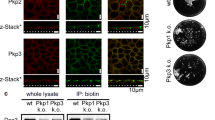Abstract.
The cytokeratin-binding, basic 80.5 kDa polypeptide plakophilin 1 (“band 6 protein” of bovine muzzle desmosome fractions) has originally been described as a single molecular species, localized to desmosomal plaques of certain cell types, mostly stratified squamous epithelia and complex epithelia. We now report that this protein exists in at least two different isoforms: 726 amino acids (aa), plakophilin 1a; and 747 aa, plakophilin 1b. This reflects the splicing of the 21 aa-encoding exon 7 of the human plakophilin-1 gene and that each mRNA splice form can occur in two polyadenylation forms of 2.7 kb and 5.3 kb. Antibodies recognizing either isoform and/or others that are specific for the exon-encoded sequence of form 1b have allowed, in combination with immunolocalization protocols minimizing losses of diffusible proteins, the detection of both isoforms in the nucleoplasm of diverse kinds of cultured cells and tissues, including desmosome-forming cells as well as cells that never form desmosomes. The protein has also been identified in manually isolated nuclei (germinal vesicles) of Xenopus laevis oocytes. Plakophilin 1a accumulates in nuclei as shown by suitable immunolocalization protocols and upon overexpression following transfection with cDNAs, but is also located in desmosomes of stratified and complex epithelia. By contrast, isoform 1b has been found exclusively in nuclei, even in cells connected by desmosomes immunostained with plakophilin 1a-reactive antibodies. We conclude that plakophilins 1a and 1b are constitutive nuclear proteins encoded by the same gene, which is not expressed in relation to epithelial differentiation pathways, whereas the additional appearance of plakophilin 1a in desmosomal plaques of stratified and complex epithelia is regulated by an as yet unknown mechanism of differentiation-dependent topogenic recruitment. Possible functions of plakophilins are discussed in relation to recent reports of the involvement of other members of the armadillo/plakoglobin multigene family of proteins in cell surface-gene regulation signalling pathways.
Similar content being viewed by others
Author information
Authors and Affiliations
Additional information
Received: 29 April 1997 / Accepted: 3 June 1997
Rights and permissions
About this article
Cite this article
Schmidt, A., Langbein, L., Rode, M. et al. Plakophilins 1a and 1b: widespread nuclear proteins recruited in specific epithelial cells as desmosomal plaque components. Cell Tissue Res 290, 481–499 (1997). https://doi.org/10.1007/s004410050956
Issue Date:
DOI: https://doi.org/10.1007/s004410050956




